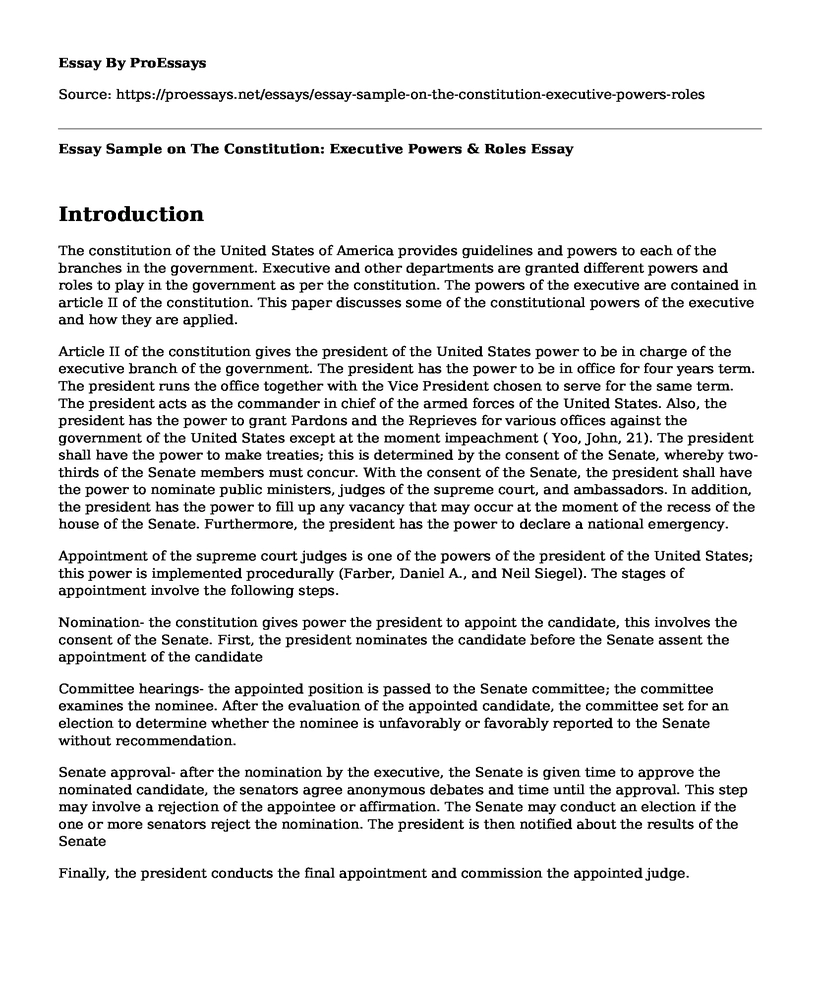Introduction
The constitution of the United States of America provides guidelines and powers to each of the branches in the government. Executive and other departments are granted different powers and roles to play in the government as per the constitution. The powers of the executive are contained in article II of the constitution. This paper discusses some of the constitutional powers of the executive and how they are applied.
Article II of the constitution gives the president of the United States power to be in charge of the executive branch of the government. The president has the power to be in office for four years term. The president runs the office together with the Vice President chosen to serve for the same term. The president acts as the commander in chief of the armed forces of the United States. Also, the president has the power to grant Pardons and the Reprieves for various offices against the government of the United States except at the moment impeachment ( Yoo, John, 21). The president shall have the power to make treaties; this is determined by the consent of the Senate, whereby two-thirds of the Senate members must concur. With the consent of the Senate, the president shall have the power to nominate public ministers, judges of the supreme court, and ambassadors. In addition, the president has the power to fill up any vacancy that may occur at the moment of the recess of the house of the Senate. Furthermore, the president has the power to declare a national emergency.
Appointment of the supreme court judges is one of the powers of the president of the United States; this power is implemented procedurally (Farber, Daniel A., and Neil Siegel). The stages of appointment involve the following steps.
Nomination- the constitution gives power the president to appoint the candidate, this involves the consent of the Senate. First, the president nominates the candidate before the Senate assent the appointment of the candidate
Committee hearings- the appointed position is passed to the Senate committee; the committee examines the nominee. After the evaluation of the appointed candidate, the committee set for an election to determine whether the nominee is unfavorably or favorably reported to the Senate without recommendation.
Senate approval- after the nomination by the executive, the Senate is given time to approve the nominated candidate, the senators agree anonymous debates and time until the approval. This step may involve a rejection of the appointee or affirmation. The Senate may conduct an election if the one or more senators reject the nomination. The president is then notified about the results of the Senate
Finally, the president conducts the final appointment and commission the appointed judge.
Conclusion
Currently, the powers of the president have been misused on several occasions. The power of the president to declare a national emergency is one the controversial issue concerning abuse of presidential powers. In the current news, the president of the united states declared a national emergency in order to build a wall along the border of the United States and Mexico. This presidential declaration is considered as one of the worst declarations that have ever been made. Congress refused to fund the project. As a result; it has led to political disputes. According to my opinion, this declaration is unconstitutional; the president abused his power by declaring a national emergency over this project without considering the consent of the other departments as well as the public. Under the law of national emergency, the constitution of the united states grants power the house of representatives to pass a resolution to determine the state of emergency; they can terminate following the consent of the Senate. However, according to the news, the president criticized these opinions and legal procedures.
Works Cited
Yoo, John C. "The Executive Power of Reversal." Harv. JL & Pub. Poly 42 (2019): 59.
Farber, Daniel A., and Neil Siegel. "United States Constitutional Law." Available at SSRN (2019).
Cite this page
Essay Sample on The Constitution: Executive Powers & Roles. (2023, Jan 25). Retrieved from https://proessays.net/essays/essay-sample-on-the-constitution-executive-powers-roles
If you are the original author of this essay and no longer wish to have it published on the ProEssays website, please click below to request its removal:
- Dacosta's Article on the "Audacity of Canada 150" Review
- Paper Example on Immigration Policy Changes Due To the 9/11 Attack
- Government's Involvement in Social Issues Essay
- Nuclear Weapons Do Not Matter Essay Example
- Karl Marx: Creator of Marxism & Analyzer of Capitalism - Essay Sample
- U.S. Health Care: Politics and Policy Impact on Quality Care - Essay Sample
- Paper Example on Liberalism in Modern-Day International Relations: Respect, Elections, Rights & Government







